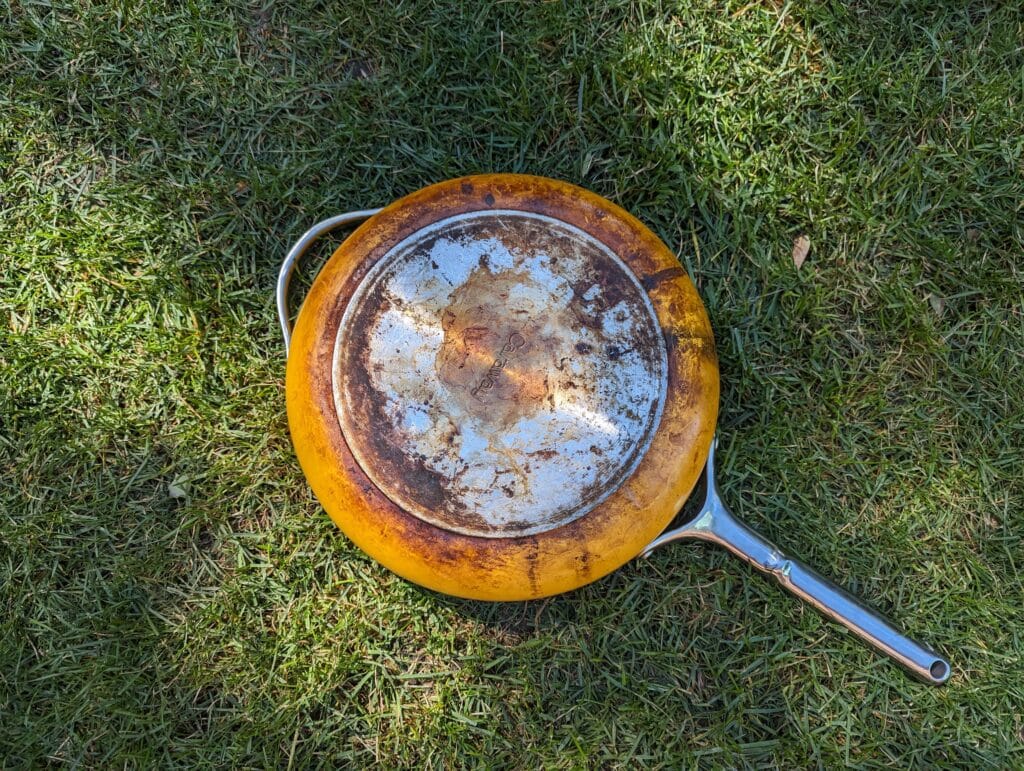We get a lot of reader questions about cookware safety, both about existing brands and old pans. Here is a step-by-step process to follow to test your cookware for dangerous heavy metals.

Table of Contents
Before cooking with any old cookware made of ceramic, porcelain, aluminum, copper, or what looks like stainless steel, test the cookware for leaching, especially for metals like lead.
Here’s how to test cookware for leaching.
How to test your cookware at home
For old aluminum pots and pans, here’s a simple home test for aluminum leaching:
- Fill the pot or pan with water
- Add two tablespoons of cream of tartar for every quart of water
- Boil the water for about 15 minutes, then let it cool
- If the water turns cloudy or has a metallic taste, the cookware might be leaching aluminum.
Here’s how to test copper or unlined aluminum cookware using an acid test for leaching:
- Fill the cookware with a mixture of half vinegar and half water
- Boil the mixture for about 15 minutes
- If the mixture turns green (for copper) or if you detect a metallic taste (for aluminum), the cookware may be leaching metals.
For all old cookware, especially pots and pans with a glaze, use a home Lead Test kit:
- Purchase a lead test kit from a hardware store or online. Options include:
- 3M LeadCheck kit – discontinued as of October 2023, so stock up if you like these! (View on The Home Depot)
- ProLab (View on The Home Depot)
- ESCA lead test kits for paint
- These kits usually come with swabs that change color when they come into contact with lead
- A color change (often to pink or red) usually indicates the presence of lead.
Don’t donate bad cookware!
If you detect lead using a home test kit, or get a positive result for aluminum or copper, don’t use the pot or pan and for the sake of others’ safety, don’t donate it!
Depending on the material, you could take it to the recycling center or repurpose it as a (non-food) plant pot or other decoration.
Don’t assume a negative test means safety
If your tests come back negative, don’t assume the cookware is safe. Instead, move onto the next step: professional testing.
Why?
Because while the home lead test kits can detect surface lead, they aren’t usually sensitive enough to detect low levels of lead or lead that might leach out during cooking. The same goes for the sensitivity of home tests for copper and aluminum.
Professional Testing Options
For a more comprehensive lead, aluminum, and heavy metal analysis, consider sending a sample of your cookware to a certified laboratory.
Bear in mind that to send a sample of the cookware for professional testing, you may have to damage and sacrifice part of a cookware collection. And even if you test one pot or pan for leaching, and it passes as safe, that doesn’t always mean its companion pieces are safe.
A certified lab can test for various metals and provide a detailed report.
This option is more expensive than a home lead or aluminum test but is also more accurate.
It’s hard, however, to find good options for professional cookware testing unless it’s on behalf of a cookware company.
Your best option may be to contact FDA approved labs for lead testing and see if they’ll accept consumer samples for testing.
Another way to test for leaching is to carefully create samples of food for professional testing using the cookware. This may mean cooking fresh tomatoes or another acidic food in the cookware according to specific testing methods and then sealing and mailing the samples to a lab such as NPAL.
You might also want to contact the following labs:
The limits of home tests and XRF testing
X-ray fluorescence (XRF) testing can identify the elements in cookware. XRF doesn’t, however, tell you anything about potential exposure to those elements. This is because while a material might contain lead or other heavy metals, they’re often inside the material, unable to leach out.
Similarly, home lead tests only measure lead in the top layers of a material, and only in the area where you rub the swab. These tests can create false positives and aren’t especially accurate. They can support the need for further testing, however. You may want to test the same cookware two or three times to verify results.
I wrote extensively on this issue in my article on Caraway Cookware and Heavy Metals.
In contrast, leach testing measures how much, if any, lead and other metals can be extracted from cookware under normal use. This reflects the real-life hazard of cookware and is very accurate and sensitive.
Keep monitoring and checking your cookware
Even if you’ve tested your pots and pans at home and professionally, proper care and maintenance is essential for safety. As are regular checks of the integrity of the cookware.
Check all pots and pans for worn out linings, chips, cracks, and other damage before every use. If enamel coated cookware is scratched or chipped, for instance, it could leach metal from the base material.